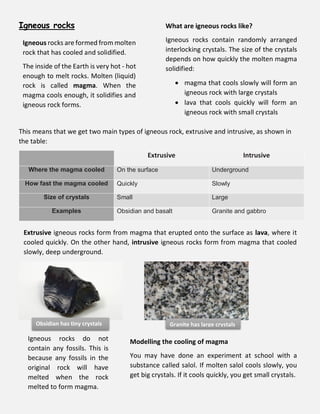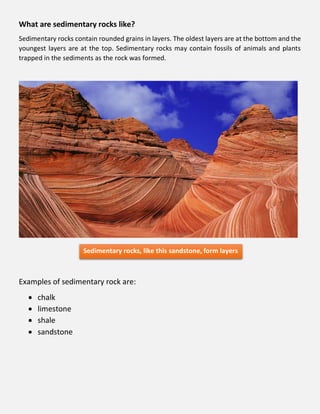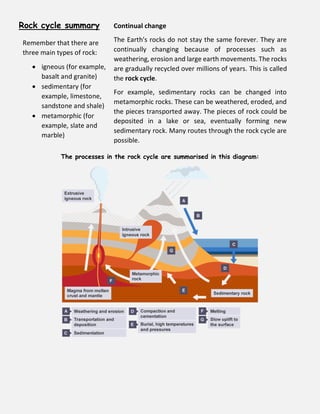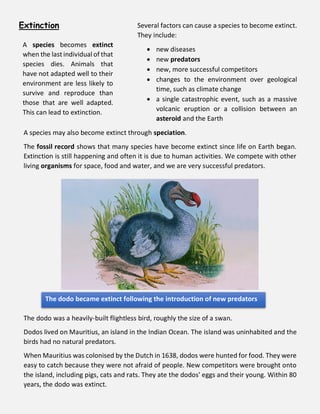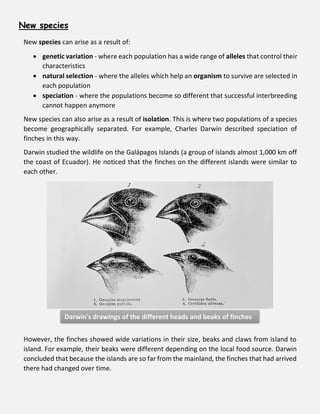Rocks.pdf
- 1. Rocks There are three main types of rock: igneous, sedimentary and metamorphic. They are formed in different ways and have different properties. Introduction to rocks Rocks are solid at room temperature. They are made of grains that fit together. Each grain in a piece of rock is made from a mineral, which is a chemical compound. The grains in a rock can have different: colours shapes sizes Granite has interlocking grains Sandstone has rounded grains Porous rocks Rocks with rounded grains are more likely to absorb water than rocks with interlocking grains. This is because the water can get into the gaps between the grains. Rocks that absorb water are described as being porous. Rocks with rounded grains are usually softer and more crumbly than rocks with interlocking grains. So porous rocks tend to be softer than non-porous rocks. Rocks with interlocking grains are more likely to be hard and non-porous Rocks with rounded grains are more likely to be crumbly and porous
- 2. Igneous rocks This means that we get two main types of igneous rock, extrusive and intrusive, as shown in the table: Extrusive Intrusive Where the magma cooled On the surface Underground How fast the magma cooled Quickly Slowly Size of crystals Small Large Examples Obsidian and basalt Granite and gabbro Igneous rocks are formed from molten rock that has cooled and solidified. The inside of the Earth is very hot - hot enough to melt rocks. Molten (liquid) rock is called magma. When the magma cools enough, it solidifies and igneous rock forms. What are igneous rocks like? Igneous rocks contain randomly arranged interlocking crystals. The size of the crystals depends on how quickly the molten magma solidified: magma that cools slowly will form an igneous rock with large crystals lava that cools quickly will form an igneous rock with small crystals Extrusive igneous rocks form from magma that erupted onto the surface as lava, where it cooled quickly. On the other hand, intrusive igneous rocks form from magma that cooled slowly, deep underground. Obsidian has tiny crystals Granite has large crystals Igneous rocks do not contain any fossils. This is because any fossils in the original rock will have melted when the rock melted to form magma. Modelling the cooling of magma You may have done an experiment at school with a substance called salol. If molten salol cools slowly, you get big crystals. If it cools quickly, you get small crystals.
- 3. Sedimentary rocks Here are the different processes in order: Sedimentary rocks are formed from the broken remains of other rocks that become joined together. A river carries, or transports, pieces of broken rock as it flows along. When the river reaches a lake or the sea, its load of transported rocks settles to the bottom. We say that the rocks are deposited. The deposited rocks build up in layers, called sediments. This process is called sedimentation. The weight of the sediments on top squashes the sediments at the bottom. This is called compaction. The water is squeezed out from between the pieces of rock and crystals of different salts form. The crystals stick the pieces of rock together. This process is called cementation. These processes eventually make a type of rock called sedimentary rock. It may take millions of years for sedimentary rocks to form. transport → deposition → sedimentation → compaction → cementation 1. Small pieces of rock are transported by a river 2. Pieces of rock are deposited and layers of sediment build up 3. Sediments are compacted and water is squeezed out. Crystals form, which cement the pieces of rock together
- 4. What are sedimentary rocks like? Sedimentary rocks contain rounded grains in layers. The oldest layers are at the bottom and the youngest layers are at the top. Sedimentary rocks may contain fossils of animals and plants trapped in the sediments as the rock was formed. Examples of sedimentary rock are: chalk limestone shale sandstone Sedimentary rocks, like this sandstone, form layers
- 5. Metamorphic rocks Metamorphic rocks are formed from other rocks that are changed because of heat or pressure. They are not made from molten rock – rocks that do melt form igneous rocks instead. Earth movements can cause rocks to be deeply buried or squeezed. As a result, the rocks are heated and put under great pressure. They do not melt, but the minerals they contain are changed chemically, forming metamorphic rocks. Metamorphic rocks may form from rocks heated by nearby magma What are metamorphic rocks like? Marble is formed from limestone and contains tiny interlocking grains. The layers in slate, formed from shale, are arranged in layers. This makes slate useful for making roof tiles because it can be split into separate flat sheets. Slate is a metamorphic rock that can be split into thin sheets, which makes it ideal for roof tiles Metamorphic rocks rarely contain fossils. Any that were present in the original sedimentary rock will not normally survive the heat and pressure.
- 6. The Rock Cycle Rocks gradually wear away, a process called weathering. Biological, chemical and physical weathering are three types of weathering. Weathering and erosion are part of the rock cycle. People can even cause biological weathering just by walking. Over time, paths in the countryside become damaged because of all the boots and shoes wearing them away. Biological weathering Weathering is the breaking down or wearing away of rocks where they are. It does not happen because they move or collide with each other. One type, biological weathering, is caused by animals and plants. For example, rabbits and other burrowing animals can burrow into a crack in a rock, making it bigger and splitting the rock. You may have seen weeds growing through cracks in the pavement. If you have gone for a walk in the countryside, you may even have seen bushes or trees growing from cracks in rocks or disused buildings. This is because plant roots can grow in cracks. As they grow bigger, the roots push open the cracks and make them wider and deeper. Eventually pieces of rock may fall away. Trees can grow out of rocks, with their roots finding and making cracks
- 7. Chemical weathering The weathering of rocks by chemicals is called chemical weathering. Rainwater is naturally slightly acidic because carbon dioxide from the air dissolves in it. Minerals in rocks may react with the rainwater, causing the rock to be weathered. Some types of rock are easily weathered by chemicals. For example, limestone and chalk are mostly calcium carbonate. When acidic rainwater falls on limestone or chalk, a chemical reaction happens. New, soluble, substances are formed in the reaction. These dissolve in the water, and then are washed away, weathering the rock. Chemical weathering can produce caves made of limestone Some types of rock are not easily weathered by chemicals. For example, granite and gabbro are hard rocks that are weathered only slowly. However, some of their minerals do react with the acids in rainwater to form new, weaker substances that crumble and fall away. Acid rain Coal, oil and natural gas are fossil fuels. When they are used, carbon dioxide and sulphur dioxide escape into the air. When the sulphur dioxide dissolves in the water in the clouds, it makes acid rain – rainwater that is more acidic than normal. Acid rain harms fish and trees, but it also makes chemical weathering happen more quickly. Buildings and statues made from rock are damaged as a result. This is worse when the rock is limestone rather than granite. Stone carvings damaged by acid rain
- 9. Erosion and transport Physical weathering Physical weathering is caused by physical processes such as changes in temperature, freezing and thawing, and the effects of wind, rain and waves. Temperature changes When a rock gets hot it expands a little, and when it gets cold the rock contracts a little. If a rock is heated and cooled many times, cracks form and pieces of rock fall away. This type of physical weathering happens a lot in deserts, because it is very hot during the day but very cold at night. Wind, rain and waves Wind, rain and waves can all cause weathering. The wind can blow tiny grains of sand against a rock. These wear the rock away and weather it. Rain and waves lashing against a rock can also wear it away over long periods of time. Freeze-thaw Water expands slightly when it freezes to form ice. This is why water pipes sometimes burst in the winter. You might have seen a demonstration of this sort of thing - a jar filled to the brim with water eventually shatters after it is put into a freezer. The formation of ice can also break rocks. If water gets into a crack in a rock and then freezes, it expands and pushes the crack further apart. When the ice melts later, water can get further into the crack. When the water freezes, it expands and makes the crack even bigger. This process of freezing and thawing can continue until the crack becomes so big that a piece of rock falls off. Erosion Weathering and erosion are often confused: weathering is the wearing away of rocks erosion is the movement of the broken pieces away from the site of weathering For example, a limestone cliff may be weathered by freeze-thaw, a type of physical weathering. This means that rock in the cliff becomes broken into smaller pieces. Erosion happens when these pieces of rock fall away down the cliff.
- 10. Transport Rivers and streams can move pieces of rock. This is called transport. Fast-flowing rivers can transport large rocks, but slow-moving rivers can only transport tiny pieces of rock. As the pieces of rock are carried along by the water, they bash against each other and the river bed. They gradually wear away because of this. They become smaller and more rounded. Heaps of rocks, caused by weathering then erosion, lying at the bottom of a limestone cliff
- 11. Rock cycle summary The processes in the rock cycle are summarised in this diagram: Remember that there are three main types of rock: igneous (for example, basalt and granite) sedimentary (for example, limestone, sandstone and shale) metamorphic (for example, slate and marble) Continual change The Earth's rocks do not stay the same forever. They are continually changing because of processes such as weathering, erosion and large earth movements. The rocks are gradually recycled over millions of years. This is called the rock cycle. For example, sedimentary rocks can be changed into metamorphic rocks. These can be weathered, eroded, and the pieces transported away. The pieces of rock could be deposited in a lake or sea, eventually forming new sedimentary rock. Many routes through the rock cycle are possible.
- 12. Letter Description A Weathering breaks down rocks on the surface of the Earth. There are three types of weathering (biological physical and chemical). Wind and water move the broken rock particles away. This is called erosion. B Rivers and streams transport rock particles to other places. Rock particles are deposited in lakes and seas. C Rock particles form layers. D Compaction and cementation presses the layers and sticks the particles together. This creates sedimentary rock. E Rocks underground get heated and put under pressure, and are changed into metamorphic rock. F Rocks underground that get heated so much they melt turn into magma. Magma also comes from deeper inside the Earth, from a region called the mantle. Pressure can force magma out of the ground, creating a volcano. When the magma (lava) cools quickly, it turns into solid extrusive igneous rock. Magma that cools slowly underground forms solid intrusive igneous rock. G Areas of rock can move slowly upwards, pushed up by pressure of the rocks forming underneath. This is called uplift.
- 13. Fossils A fossil is the preserved remains or traces of a dead organism. Fossils are found in rocks and can be formed from: Hard body parts, such as bones and shells, which do not decay easily or are replaced by other materials as they decay. Parts of organisms that have not decayed. For example, dead animals and plants can be preserved in amber, peat bogs, tar pits, or in ice. Casts or impressions, such as footprints or burrows. These become covered by layers of sediment, which eventually become rock. Fossils of ammonites - sea creatures that became extinct about 65 million years ago The fossil record Fossil remains have been found in rocks of all ages. Fossils of the simplest organisms are found in the oldest rocks, and fossils of more complex organisms in the newest rocks. This supports Darwin’s theory of evolution, which states that simple life forms gradually evolved into more complex ones. Fossils contained in layers of sediment - Evidence for early forms of life comes from fossils. By studying fossils, scientists can learn how much (or how little) organisms have changed as life developed on Earth. However, many early forms of life were soft-bodied so they have left few traces behind.
- 14. Evolution of the horse Scientists have a fairly complete fossil record for the evolution of the horse. It shows that over 50 million years, the horse evolved from a dog-sized creature that lived in rainforests into an animal standing up to 2 metres high and adapted to living on the plains. Its multi-toed feet, adapted for walking across the forest floor, evolved into single- toed hooves more suited for running over open country. Horses through the ages
- 15. Extinction A species becomes extinct when the last individual of that species dies. Animals that have not adapted well to their environment are less likely to survive and reproduce than those that are well adapted. This can lead to extinction. Several factors can cause a species to become extinct. They include: new diseases new predators new, more successful competitors changes to the environment over geological time, such as climate change a single catastrophic event, such as a massive volcanic eruption or a collision between an asteroid and the Earth A species may also become extinct through speciation. The fossil record shows that many species have become extinct since life on Earth began. Extinction is still happening and often it is due to human activities. We compete with other living organisms for space, food and water, and we are very successful predators. The dodo became extinct following the introduction of new predators The dodo was a heavily-built flightless bird, roughly the size of a swan. Dodos lived on Mauritius, an island in the Indian Ocean. The island was uninhabited and the birds had no natural predators. When Mauritius was colonised by the Dutch in 1638, dodos were hunted for food. They were easy to catch because they were not afraid of people. New competitors were brought onto the island, including pigs, cats and rats. They ate the dodos' eggs and their young. Within 80 years, the dodo was extinct.
- 16. New species New species can arise as a result of: genetic variation - where each population has a wide range of alleles that control their characteristics natural selection - where the alleles which help an organism to survive are selected in each population speciation - where the populations become so different that successful interbreeding cannot happen anymore New species can also arise as a result of isolation. This is where two populations of a species become geographically separated. For example, Charles Darwin described speciation of finches in this way. Darwin studied the wildlife on the Galápagos Islands (a group of islands almost 1,000 km off the coast of Ecuador). He noticed that the finches on the different islands were similar to each other. Darwin's drawings of the different heads and beaks of finches However, the finches showed wide variations in their size, beaks and claws from island to island. For example, their beaks were different depending on the local food source. Darwin concluded that because the islands are so far from the mainland, the finches that had arrived there had changed over time.
- 17. Adaptations for cold climates The Arctic is cold and windy with very little rainfall. Plants in the Arctic often grow very close to the ground and have small leaves. This helps to conserve water and to avoid damage by the wind. The polar bear Polar bears are well adapted for survival in the Arctic. Their adaptations include: a white appearance - as camouflage from prey on the snow and ice thick layers of fat and fur - for insulation against the cold a small surface area to volume ratio - to minimise heat loss a greasy coat that sheds water after swimming - to help reduce heat loss large feet - to distribute their load and increase grip on the ice The polar bear is adapted to life in a cold climate
- 18. Adaptations for hot climates Deserts are hot by day, cold at night, and receive very little rainfall. The camel Camels are well adapted for survival in the desert. Their adaptations include: large, flat feet - to spread their weight on the sand thick fur on the top of the body for shade, and thin fur elsewhere to allow easy heat loss a large surface area to volume ratio - to maximise heat loss the ability to go for a long time without water - they lose very little water through urination and perspiration the ability to tolerate body temperatures up to 42°C slit-like nostrils and two rows of eyelashes - to help keep out sand Camels are adapted to life in a hot climate Desert plants Cacti are also well adapted for survival in the desert. Their adaptations include: stems that can store water widespread root systems that can collect water from a large area In addition, cacti have spines instead of leaves. These minimise the surface area and so reduce water loss by transpiration. The spines also protect the cacti from animals that might eat them. The stems of cacti are able to store water

